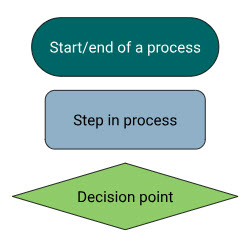
Step 3: Create your PrEP process map
|
Task
|
Time (minutes)
|
Team Members Responsible:
|
|
Pre-work 1
|
30
|
As decided by team members
|
|
Team Meeting 1
|
90
|
All
|
|
Pre-work for Team Meeting 2
|
90
|
Process Map Designer(s)
|
|
Team Meeting 2
|
60
|
All
|
|
Pre-work for Team Meeting 3
|
90
|
Process Map Designer(s)
|
|
Team Meeting 3
|
90
|
All
|
|
Pre-work for Team Meeting 4
|
90
|
Process Map Designer(s)
|
|
Team Meeting 4
|
75
|
All
|
Before Team Meeting #1
Duration: 30 minutes
1. Once all team members have completed Steps 1 and 2, schedule the four team meetings outlined in this step.
2. Determine if the meetings will happen virtually or in person.
3. Identify software that you can use for process mapping, such as Powerpoint, Google Slides, Microsoft Visio, Canva, or Miro. The software should be something that several people on your team have access to edit, so that the map can be updated regularly to reflect changes to the workflow.
4. Ensure that all team members have printed copies or online access to Team Meeting #1 agenda (below).
5. If Team Meeting #1 is happening in-person, decide if the first draft of the process map will be created on paper or in software. If on paper, obtain sticky notes in 3 different colors, or in the shape of ovals, rectangles, and diamonds to allow differentiation of steps.
Team Meeting #1 Agenda
Duration: 90 minutes
- Share your answers to the questions outlined in Steps 1 and 2. Discuss the similarities and differences between each team member’s vision for the process map and PrEP workflow.
- Identify team roles:
- Meeting Facilitator: Select one for each of the 4 team meetings. Team members can rotate through this role. This role does not require work in between meetings.
- Notetaker: Responsible for recording notes during each of the meetings in a document that is easily accessible to all team members. Team members can rotate through this role. This role does not require work in between meetings, and could be combined with the Materials Coordinator role.
- Materials Coordinator: Responsible for ensuring that all team members have printed copies or online access to the relevant agendas and worksheets for each step. Team members can rotate through this role. This role requires work in between meetings, and could be combined with the Notetaker role.
- Process Map Designers: Can be 1 or 2 team members. These team members will be responsible for drafting and revising the process map in the identified software. They also will be responsible for displaying the draft process map on a screen during Team Meetings #2 - #4. This role requires work in between meetings, and is the biggest time commitment.

- As a team, verbally walk through the entire PrEP workflow that you would like to map. When a patient walks in the door and expresses interest in PrEP, what is the workflow that follows? Share every nitty gritty detail!
- As each step of the workflow is shared, the Notetaker or a Process Map Designer should record it within the appropriate shape (see shapes to the right). If creating the first draft of the process map on paper, the Notetaker should record the steps on sticky notes. If creating the draft using software, a Process Map Designer should record the steps on shapes in the software.
- Steps may include:
- PrEP screening and intake
- Providing PrEP education
- PrEP financing and payment
- Placing a PrEP order set for lab tests in the EHR
- Conducting lab tests
- Onsite prescribing
- Connecting or referring to support services
- Documenting sexual history, lab results, and patient outreach in the EHR
- Conducting PrEP follow-up
- As steps are shared, team members can ask follow-up questions to delineate staff roles and responsibilities, such as:
- Which staff types are responsible for conducting this step?
- What services/departments are involved?
- What other staff need to be alerted or involved when specific steps occur? How are they notified?
- What is the location of each step?
- How do staff coordinate with referral partners?
- What information is documented during this step?
- Why is this information documented?
- How is this information documented?
- Where is health IT or the EHR used in the process? Examples include:
- Documentation of gender identity in EHR
- Standardized sexual history template
- PrEP problem code
- PrEP order set
- Clinical Decision Support tools
- PrEP episode of care
- Documentation of lab results in EHR
- Telephone encounters
- PrEP patient registry
- Telehealth visits
- Patient portal
- Adherence support apps
- Team Discussion:
- What challenges are we facing with our PrEP processes in our current clinical and EHR workflow?
- In what areas are our PrEP processes not clear? Where are we documenting things differently across clinics, providers, or teams?
- How can our process mapping work address those challenges and clarify our processes?
- As a team, decide what the first and last steps of the PrEP process map should be. This decision should be informed by the Team Discussion questions.
- Does the team want to map out the entire PrEP process, from initial assessment of PrEP eligibility to the follow-up visits? Or does the team want to focus on a specific component of the PrEP process, such as initiation or adherence and retention in care?